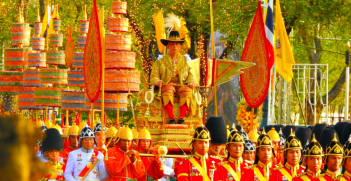Timor-Leste’s ASEAN Aspirations Can Benefit from Pragmatic Indecision
Timor-Leste continues in its quest to join ASEAN, but while the geographical logic of Timor-Leste’s ASEAN membership will inevitably win out, it could be to the tiny new nation’s advantage to sit it out for the time being, rather than perpetuate an ASEAN pattern of attempting too much with too little.
On 20 April, one week prior to the 26th ASEAN Summit, Timor-Leste’s Minister of Foreign Affairs and Cooperation, Hernanin Coelho da Silva, paid a visit to the ASEAN Secretary General Le Luong Minh. Ahead of the Summit, the Minister reaffirmed his country’s determination to join ASEAN, and reiterated Timor-Leste’s commitment to ASEAN as its key foreign policy priority. Timor-Leste, he said, ‘is making intensive preparations to boost its institutional capacity and human capital to participate in ASEAN activities.’ Similarly, Timor-Leste’s Ambassador to Malaysia, Amorim Dias, took the opportunity of Malaysia’s chairmanship of ASEAN in 2015, to state that ‘member countries can accept our application as soon as possible’, assuring them that Timor-Leste was not looking for financial support, but could pay its way.
To become a member of ASEAN, Timor-Leste, which achieved independence in 2002, must have a permanent Secretary of State for ASEAN within its Foreign Ministry and embassies in all ten ASEAN nations. Since formally applying for ASEAN membership in March 2011, Timor-Leste has established six Southeast Asia embassies and the remainder are promised by 2016. The tiny nation’s government website lists only 17 overseas missions in its diplomatic network. To bring this into perspective, Indonesia—ASEAN’s largest member state—has 132 diplomatic missions (95 embassies, 31 consulates general and 3 consulates, plus 3 permanent United Nations missions). Myanmar, among ASEAN’s weaker states, lists just 37 diplomatic posts. Herein lies a key difficulty in Timor-Leste’s bid. ASEAN—comprising Brunei Darussalam, Cambodia, Indonesia, Laos, Malaysia, Myanmar, Philippines, Singapore, Thailand and Vietnam—is already hampered by a deep divide in terms of diplomatic and economic capacity.
In January 2015, the findings of a study by Economy Watch on the ASEAN states’ domestic capacity were reported. The study identified average levels of ASEAN governments’ spending on their own citizens, which provided an indication of the degree to which they could meet their peoples’ needs and expectations. The ASEAN average was reported to be $730 per person, per annum. In Indonesia, ASEAN’s largest economy, the average per person was around $600. In Myanmar it was just $40, while in oil rich Brunei Darussalam it was $15,000. (Australia, it was reported, spends on average $16,800 per person, per year.) These figures provide a critical insight into the economic fragility, and potential for political instability, lurking at the heart of ASEAN. This is, of course, already manifest around the region, however the study confirms a structural unevenness that will not be helped by adding an eleventh member. It also sheds a little unwanted light onto the problems faced in achieving an ASEAN Economic Community (AEC) by the end of 2015.
Ambassador Dias suggested that ASEAN membership for Timor-Leste would deliver ‘a lot of benefits, including in areas of trade, security, [and] stability of the country’. In considering just one area, trade, Timor-Leste might be better served continuing to hedge its bilateral and multilateral bets. The country is still heavily imports dependent. In 2012 its imports amounted to US$670 million, while its exports generated a mere US$31 million. In 2014, over half of those imports came from its neighbours—Indonesia (34.3%), Malaysia (15.4%) and Singapore (12.8%). Timor-Leste’s export markets, on the other hand, were dominated by Indonesia (34.7%), Germany (14.5%), the United States (13.8%) and Australia (10.2%). Australia, in addition, is by far the largest aid donor, contributing $108 .1 million in 2013-14 and $96.6 million in 2014-15.
This unreciprocated bilateral trade relationship with its ASEAN neighbours (Indonesia excepted) has left some East Timorese wary of what multilateral economic engagement with ASEAN would deliver. There are concerns that ASEAN membership would not only increase its already substantial import dependence, but it might find itself flooded with cheap goods from ASEAN countries under its web of free trade agreements. There is also concern that membership of the AEC could expose Timor-Leste’s developing economy to unwelcome risks that could damage its development needs. Timorese NGO La’o Hamutuk also argues that low levels of local production and underdeveloped market access regulations would see few economic benefits flow from joining ASEAN.
As is ‘the ASEAN Way’, none of these uncomfortable truths need be publicly aired. After the 26th ASEAN Summit the Chairman’s Statement ‘welcomed the progress made by the ASEAN Coordinating Council Working Group (ACCWG) in deliberating the ASEAN Membership Application by Timor-Leste.’ ASEAN would further explore the activities that Timor-Leste could participate in, while it committed to provide assistance for Timor-Leste’s capacity building process. The Chairman’s Statement was decidedly open-ended in a spirit of pragmatic indecision. This can serve Timor-Leste’s interests well in the medium term—accepting ASEAN support in building its diplomatic capability; leveraging the goodwill of bilateral trading partners (especially in building export markets); and quietly observing the increasingly complex strategic environment that ASEAN must navigate.
While the geographical logic of Timor-Leste’s ASEAN membership will inevitably win out, it could be to the tiny new nation’s advantage to sit it out for the time being, rather than perpetuate an ASEAN pattern of attempting too much with too little.
Dr Sally Percival Wood is co-editor of The Australia-ASEAN Dialogue: Tracing 40 Years of Partnership (Palgrave Macmillan, 2014) with Boagang He and Our Place in the Asian Century: Southeast Asia as ‘The Third Way’ (Asialink, The Univesity of Melbourne, 2012) with Tony Milner. She is currently working on a monograph marking the 60th anniversary of Australia-Malaysia diplomatic engagement for the Department of Foreign Affairs and Trade. This article can be republished with attribution under a Creative Commons Licence.





